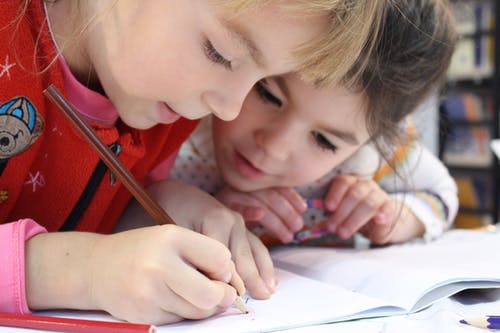
Science, STEM, STEAM and Critical Thinking Skill for Summer
Over the last few weeks we have been exploring different ways to encourage kids to stay active, curious, and prevent the dreaded “Summer Slump”. While options for reading and math were pretty straight forward, I actually actively advised against pursuing science as a summer learning activity (at least if you are trying to do so from home).
Me. The Nerd. The girl who got super excited about the prospect of trying to make her own set of balance scales as a DIY. The person who took Organic Chemistry willingly.
But yes, I do advise against parents attempting to become science teachers on their own time over the summer.
Whether your child is going into fourth grade or tenth grade next year, their science class will vary drastically depending on the state, teacher, curriculum, and even the order in which they teach the material. If you spend most of the summer quizzing your child on types of rocks only for your child’s first subject of the year to be plants, it is easy to see how resentment might begin to build, especially if they were not especially excited with the subject to begin with.
The second reason is one I have already briefly touched on in other subjects
Confused Teachers Make for Confused Students
While most of us can recognize that higher-level subjects may be beyond our ability to teach, too many parents assume 4th-grade science is a breeze (I am using 4th grade here as it is a good metric for when subjects start really diverging) and attempt to start playing teacher. But the existence of the TV show “Are you Smarter than a 5th Grader” proves that this is not always a great idea.
I once spent an additional 30 minutes at babysitting reviewing the difference between ‘rotation’ and ‘revolution’ with the parents of a fifth-grader because they kept mixing them up when quizzing her for an upcoming science test.
When was the last time, as an adult, that you had to tell an igneous rock from a metamorphic rock? Do you know the different types of clouds? Can you tell me where transpiration takes place in the water cycle?
Most of these things are stepping stones your child will learn in early science classes but which most of us don’t use and therefore don’t recall into adulthood. Even if you think you know these things, you need to be able to communicate them effectively and consistently which, unless you are a teacher yourself, is easier said than done.
Science is one of those things best taught by people who know what they are doing. But this does not mean you can’t still enjoy it.
Starter Science for Tiny Humans
While new material is best taught by professionals, there are still a lot of ways to encourage a passive interest in science at home and keep kids curious without having to dive into new material.
Interactive activities for young kids are a great way to incorporate science in a non-instructional way. And they also happen to be a great chance to spend time together as a family.
Summer STEM & STEAM for Kids Ages 5-8
Kiwi Co.
Lately, there has been some chit chat in the nanny community about the interactive STEM and STEAM kits from Kiwi Co. The general consensus seems to be that these are fun, engaging ways to get kids building and observing the world around them in a way that is geared towards science or engineering. Having never purchased any of their products myself I cannot say definitively the education value of these products, but, as with any toy, if it occupies your child for a few hours at a time I would definitely call it a win.
K’NEX and Legos
The mortal enemy of bare feet for decades, Legos and K’NEX are actually a great way to introduce kids to a variety of scientific principals. From logical reasoning, critical thinking and active problem solving, to design, physics, and mechanics.
These sorts of toys are brilliant, especially if you are working with a basic kit. More complicated designer sets for things like fairy castles and Ferris wheels, aside from being more expensive, actually limit creative freedom. They are less about figuring and reasoning and more about following directions. Working with basic sets really tests what you are capable of coming up with on your own and challenges kids to think in new and different ways, which, of course, is the entire point.
Workbooks
Again, if you are looking to ‘teach’ your child science over the summer you are looking the wrong direction. However, if you are looking for something to keep them busy and maybe stop them forgetting quite so much before the following school year, there are worse options than summer workbooks. Theses usually cover a variety of subjects, though individual subject workbooks (math, writing, science) do exist and are easy to find online for a relatively low price. Workbooks can also be a good option if you have a younger child who is particularly routine-oriented as some kids do struggle with the structure to no-structure transition. Some of the best workbooks for younger kids are;

- BrainQuest
- TinkerActive
- SummerBridge
- Highlights
- Kids Summer Academy
Some of these books are available in only science, others are compilation books covering a broader range of subjects. Many also tend to include live action experiments as science is best learned through an interactive process which may require adult assistance. Again, I would only use these if you had a routine oriented younger child for whom they are a good fit.
Family Science for Summer
You will often here science teachers saying that ‘Science is all around us’. The reason why – is because it is true.
Science, in general, is interactive. Between the weather patterns caused by different cloud formations, the water cycle and it’s the effect on plant growth, even down to the physics of a regular paper airplane. Science is all around us, which means there are a variety of fun family activities that you can engage in beyond a lesson book to help keep kids curious and engaged.
Gardening for Science
If you are looking for something a little more interactive, growing your own garden is a great way to begin introducing earth science concepts. Even a window box garden has loads of opportunities to talk about what makes plants grow, different types of soil and rocks, the different benefits of eating different foods, nutrition, even those cloud types we mentioned earlier if you are looking for rain.
This kind of activity is obviously more hands-on and requires a little learning yourself, but is a great way to spend time with the kiddos. I want to emphasize that this option is not a lecture hall, it is an opportunity to spend quality time together while maybe learning a little bit along the way. Plus, at the end of it all, you have your own strawberries to pick or snap peas to grow.
You can check out The Nerdy Nanny’s channel for fun videos on how to get started with your very own window garden!
Building for Science
Whether it is a K’NEX Ferris Wheel or a DIY Bat House, a Constellation Projector or a remote-controlled Airplane, there is a huge variety of build-able activities available to kids of all different age levels. They come in all different levels and price ranges depending on your child’s ability and are a great way to spend time as a family. And many of them are so much fun that the fact that they are a science-based learning experience is almost overlooked. Here are just a few of the possible activities below;
- K’NEX – Ferris Wheel, Roller Coaster, Machines
- DIY Bat House
- Constellation Projector
- Remote Controlled Airplane
- Bottle Rocket Launcher
- Newspaper Structures
- Popsicle Stick Bridge
- Rube Goldberg Machine
Cooking and Baking for Science
Do I secretly just want families to spend more time together in the kitchen? Yes. Do I also happen to think that baking and cooking together are great ways to incorporate everyday math, science, and reading concepts? Absolutely.
From the fractions of measuring cups to the ounces and grams of weighing out ingredients, math is an essential part of every recipe. Reading through ingredients and step by step instructions may not be the chapter books you thought your child needed, but the language used in most recipes is rarely simplified and needs to clearly understood. Real-life word problems at their best.
But where is the science?
Salt, acid, fat, heat – beyond being an awesome cookbook and successful Netflix show, are the binding agents of both cooking and chemistry. Maillard reactions (browning of meat), the denaturation of proteins (eggs turning white), nixtamalization of corn or other grains (making masa or tortillas) or comparing relative density (8 ounces of sugar is 1 cup but 8 ounces of flour is 2 cups). Science abounds in the kitchen, and it is delicious.
Family Science on the Big Screen
Going to have another article – best STEM and STEAM programming per streaming network. Having a family movie night or TV tradition is a good way to allow screen time while keeping it family time. Setting up a tradition where mom and dad get to pick the or show once or twice a week is a great way to introduce a little curiosity on the sly.
From Hidden Figures to Nature Documentaries to Mythbusters Junior, there are a wealth of fascinating TV shows and movies that kids of all ages will actually enjoy.
